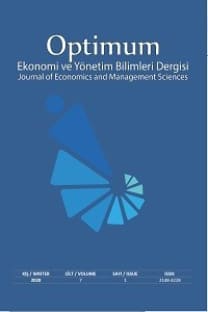Seçilmiş İslam Ülkeleri İçin Satın Alma Gücü Paritesinin Geçerliliği Üzerine Bir Çalışma
Satın Alma Gücü Paritesi, İslam Ülkeleri, Markov Rejim Değiştirme Modeli
A Study on the Validity of Purchasing Power Parity for Selected Islamic Countries
___
- Aloy, M., Boutahar, M., Gente, K., & Péguın-Feıssolle, A. (2011). Purchasing Power Parity And The Long Memory Properties Of Real Exchange Rates: Does One Size Fit All?. Economic Modelling, 28(3), 1279-1290.
- Aslan, N. & Kanbur, N. (2007). Türkiye’de 1980 Sonrası Satın Alma Gücü Paritesi Yaklaşımı. Marmara Üniversitesi İ.İ.B.F. Dergisi, 23(2), 9-43Baharumshah, A. Z., & Soon, S. V. (2012). Mean Reversion İn Bilateral Real Exchange Rates: Evidence From The Malaysian Ringgit. Applied Economics, 44(22), 2921-2933.
- Baharumshah, A. Z., Aggarwal, R., & Haw, C. T. (2007). East Asian Real Exchange Rates And Ppp: New Evidence From Panel-Data Tests. Global Economic Review, 36(2), 103-119.
- Bahmanı-Oskooee, M., & Wu, T. P. (2018). Ppp In The 34 Oecd Countries: Evidence From Quantile-Based Unit Root Tests With Both Smooth And Sharp Breaks. Applied Economics, 50(23), 2622-2634.
- Bergman, U. M., & Hansson, J. (2005). Real Exchange Rates And Switching Regimes. Journal Of International Money and Finance, 24(1), 121-138.Breitung, J., & Candelon, B. (2005). Purchasing Power Parity During Currency Crises: A Panel Unit Root Test Under Structural Breaks. Review Of World Economics, 141(1), 124-140.
- Brooks, C. (2014). Introductory Econometrics For Finance. Cambridge University Press.
- Dal Bianco, M. J. (2008). Argentinean Real Exchange Rate 1900-2006: Testing Purchasing Power Parity Theory. Estudios De Economía, 35(1), 33-64.Evans, M. D., & Lyons, R. K. (2002). Order Flow And Exchange Rate Dynamics. Journal Of Political Economy, 110(1), 170-180.
- Güriş, B., Tıraşoğlu, B. Y., & Tıraşoğlu, M. (2016). Türkiye’de Satın Alma Gücü Paritesi Geçerli Mi?: Doğrusal Olmayan Birim Kök Testleri. Sosyal Bilimler Araştırma Dergisi, 5(4), 30-42.
- Kanas, A. (2006). Purchasing Power Parity And Markov Regime Switching. Journal Of Money, Credit And Banking, 1669-1687.
- Kanas, A. (2009). Real Exchange Rates And Developing Countries. International Journal Of Finance & Economics, 14(3), 280-299.
- Kanas, A., & Genıus, M. (2005). Regime (Non) Stationarity In The Us/Uk Real Exchange Rate. Economics Letters, 87(3), 407-413.
- Lee, H. T., & Yoon, G. (2013). Does Purchasing Power Parity Hold Sometimes? Regime Switching In Real Exchange Rates. Applied Economics, 45(16), 2279-2294.
- Lothian, J. R., & Taylor, M. P. (2008). Real Exchange Rates Over The Past Two Centuries: How Important Is The Harrod‐Balassa‐Samuelson Effect? The Economic Journal, 118(532), 1742-1763.
- Nusaır, S. A. (2003). Testing The Validity Of Purchasing Power Parity For Asian Countries During The Current Float. Journal Of Economic Development, 28(2), 129-147.
- Nusaır, S. A. (2008). Purchasing Power Parity Under Regime Shifts: An Application To Asian Countries. Asian Economic Journal, 22(3), 241-266.
- Özatay, F. (2011). Parasal İktisat: Kuram Ve Politika. Efil Yayınevi. Ankara
- Rogoff, K. (1996).The Purchasing Power Parity Puzzle. Journal Of Economic Literature, 34(2), 647-668.
- Soofi, A. S. (1998). A Fractional Cointegration Test Of Purchasing Power Parity: The Case Of Selected Members Of Opec. Applied Financial Economics, 8(6), 559-566.
- Soon, S. V., Baharumshah, A. Z., & Ahn, S. K. (2015). Real Exchange Rate Dynamics In The Asian Economies: Can Regime Shifts Explain Purchasing Power Parity Puzzles? . Global Economic Review, 44(2), 219-236.
- Taguchı, H. (2010). The Pre-And Post-Crisis Real Exchange Rate Behavior In Selected East Asian Countries. Studies In Regional Science, 40(1), 27-40.
- Taylor, M. P. (2003). Purchasing Power Parity. Review Of International Economics, 11(3), 436-452.
- Telatar, E., & Hasanov, M. (2009). Purchasing Power Parity İn Transition Economies: Evidence From The Commonwealth Of İndependent States. Post-Communist Economies, 21(2), 157-173. NZurbruegg, R., & Allsopp, L. (2004).Purchasing Power Parity And The Impact Of The East Asian Currency Crisis. Journal Of Asian Economics, 15(4), 739-758.
- Yayın Aralığı: Yılda 2 Sayı
- Başlangıç: 2014
- Yayıncı: -
Ekonomik Kalkınmada Birleştirici Sosyal Sermaye Üzerine Bir İnceleme
Seçilmiş İslam Ülkeleri İçin Satın Alma Gücü Paritesinin Geçerliliği Üzerine Bir Çalışma
Ticari Dışa Açıklığın Bölgesel İşsizlik Üzerindeki Etkisi: Türkiye Örneği
Vergi Denetim Algısına Sahip Vergi Mükelleflerinin Vergi Adaleti ve Vergi Affı Uygulamalarına Bakışı
Mustafa TAYTAK, Tuğba AKYÜZ DALKIRAN
Hisse Senedi Getirilerinin Marka Değeri Duyurularına Tepkisi
Türkiye’de Petrol Fiyatlarından Enflasyona Asimetrik ve Doğrusal Olmayan Geçişkenlik
Zeki YILMAZ, Pınar ÖZER, Feride Gülsüm GÜMÜŞSOY
Kuşaklar Arası Etkileşimin Marka Bağlılığı Üzerindeki Rolü: Takım Taraftarlığı Üzerine Bir Araştırma
İlk Evlilik Süresini Etkileyen Faktörlerin Yaşam Analizi: Türkiye Örneği
